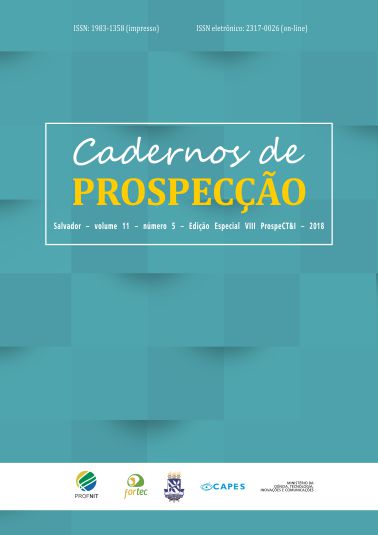Assistive Technology for People with Visual Impairment: an analysis of technological production in Brazil
DOI:
https://doi.org/10.9771/cp.v11i5.25903Keywords:
Assistive Technology, Visual Impairment, Patents.Abstract
The absence of vision influences the performance of daily activities such as reading a book, walking on the street or surfing the Internet. To execute such activities, people with visual impairment use Assistive Technologies (AT), which are products, services or environments that has as objective the improvement of functional capabilities and the integration of their users. With the purpose of finding the existent technologies and the growing technological evolution in this area, this study carried out an analyses of the national panorama of innovation of AT for visually impaired people,. The methodology was based on a patents requests research at the National Institute of Industrial Property, using the keywords "assistive technologies", "technical help", "visual impairment", "visually impaired", "blind", "blindness", "low vision" (in Portuguese), during the months of July and August of 2017. The results indicate that the national production of industrial property about AT for people with visual impairment is still limited, with focus on, mainly, mobility, orientation and scholar inclusion; and with concentration of production in the Southeast and South regions. Besides that, it was also observed that the use of the term Assistive Technology is not widespread in Brazil yet.
Downloads
References
BRACCIALLI, L. M.; ARAÚJO, R. C. T.; ROCHA, A. N. D. C. Tecnologia Assistiva: pesquisas desenvolvidas em Programas de Pós-Graduação e sua relação com a Educação Especial. Revista Diálogos e Perspectivas em Educação Especial, São Paulo, v. 2, n. 2, p. 161–172, 2015.
BRASIL. Portaria Interministerial no 362, de 25 de outubro de 2012. Dispõe sobre o limite de renda mensal dos tomadores de recursos nas operações de crédito para aquisição de bens e serviços de Tecnologia Assistiva destinados às pessoas com deficiência e sobre o rol dos bens e serviços. 2012. Disponível em: <http://www.pessoacomdeficiencia.gov.br/app/sites/default/files/arquivos/%5Bfield_generico_imagens-filefield-description%5D_58.pdf>. Acesso em: 27 jul. 2017.
BRASIL. Secretaria Nacional de Promoção dos Direitos da Pessoa com Deficiência (SNPD); Conselho Nacional dos Direitos da Pessoa com Deficiência (CONADE). Um olhar através da Convenção sobre os Direitos da Pessoa com Deficiência, da ONU: novas perspectivas e desafios. Relatório Final. In: CONFERÊNCIA NACIONAL DOS DIREITOS DA PESSOA COM DEFICIÊNCIA, Brasília, p. 156, 2013.
BRITTO NETO, L. S. et al. A Wearable Face Recognition System Built into a Smartwatch and the
Blind and Low Vision Users. In: CONFERENCE ON ENTERPRISE INFORMATION SYSTEMS, 17., Proceedings… ICEIS-2015. p. 5–12, Barcelona, Espanha.
CONDE, A. J. M. Definindo a cegueira e a visão subnormal. Instituto Benjamin Constant. 2015. Disponível em: <http://www.ibc.gov.br/?itemid=94>. Acesso em: 13 jan. 2016.
INSTITUTO BRASILEIRO DE GEOGRAFIA E ESTATÍSTICA (IBGE). Censo Demográfico 2010. Características gerais da população, Religião e Pessoas com Deficiência: publicação completa. Rio de Janeiro: IBGE, 2011. 2715 p.
______. Pesquisa anual de serviços. 1999. Disponível em: <http://www.ibge.gov.br/home/estatistica/economia/comercioeservico/pas/analisepas99.shtm>. Acesso em: 18 ago. 2017.
INSTITUTO NACIONAL DA PROPRIEDADE INDUSTRIAL (INPI). Base de dados on-line. 2017. Disponível em: <https://gru.inpi.gov.br/pePI/jsp/patentes/PatenteSearchBasico.jsp>. Acesso em: ago. 2017.
INSTITUTO NACIONAL DA PROPRIEDADE INDUSTRIAL (INPI). Diretoria de Patentes (DIRPA). Diretrizes de exame de patente de modelo de utilidade. 2012. Disponível em: <http://www.inpi.gov.br/legislacao-arquivo/docs/resolucao_85-13-anexo_diretrizes_mu.pdf> Acesso em: 18 ago. 2017.
RODRIGUES, P. R.; ALVES, L. R. G. Tecnologia assistiva – Uma revisão do tema, Holos, [S.l.], ano 29, v. 6, p. 1–179, 2013. Disponível em: <http://www.redalyc.org/html/4815/481548608014/>. Acesso em: 10 ago. 2017.
SANDNES, F. E. et al. Solving the Grand Challenges Together: a Brazil-Norway Approach to Teaching Collaborative Design and Prototyping of Assistive Technologies and Products for Independent Living. In: BERG, A. et al. (Org.). Building Community: design education for a sustainable future – INTERNATIONAL CONFERENCE ON ENGINEERING AND PRODUCT DESIGN EDUCATION, 1., 7 e 8 set. 2017, Oslo, Noruega: Akershus University College Of Applied Sciences, ed. v. Glasgow: The Design Society; Institution of Engineering Designers, 2017. p. 242–247.
SANTOS, J. C. et al. Estudo prospectivo de tecnologias assistivas educacionais para pessoas com deficiência visual . Cadernos de Prospecção, Salvador, v. 8, n. 1, p. 35–45, jan./mar. 2015.
WORLD HEALTH ORGANIZATION (WHO). WHO global disability action plan 2014–2021: better health for all people with disability. 2015. Disponível em: <http://apps.who.int/iris/bitstream/handle/10665/199544/9789241509619_eng.pdf;jsessionid=A811C2ED3D0BDFA722BCEE4882D1F890?sequence=1
______. International Classification of Functioning, Disability and Health (ICF). 2018. Disponível em: <http://www.who.int/classifications/icf/en/>. Acesso em: 14 nov. 2018.
ZITKUS, E. et al. Accessibility and usability of websites intended for people with disabilities: a preliminary study. In: Design, user experience, and usability: novel user experiences. 2016. Disponível em: <https://repositorio.unesp.br/handle/11449/162229>. Acesso em: 16 jan. 2019.
Downloads
Published
How to Cite
Issue
Section
License
Copyright (c) 2018 Cadernos de Prospecção

This work is licensed under a Creative Commons Attribution-NonCommercial 4.0 International License.
O autor declara que: - Todos os autores foram nomeados. - Está submetendo o manuscrito com o consentimento dos outros autores. - Caso o trabalho submetido tiver sido contratado por algum empregador, tem o consentimento do referido empregador. - Os autores estão cientes de que é condição de publicação que os manuscritos submetidos a esta revista não tenham sido publicados anteriormente e não sejam submetidos ou publicados simultaneamente em outro periódico sem prévia autorização do Conselho Editorial. - Os autores concordam que o seu artigo ou parte dele possa ser distribuído e/ou reproduzido por qualquer forma, incluindo traduções, desde que sejam citados de modo completo esta revista e os autores do manuscrito. - Revista Cadernos de Prospecção está licenciado com uma Licença Creative Commons Attribution 4.0. Esta licença permite que outros remixem, adaptem e criem a partir do seu trabalho para fins não comerciais, e embora os novos trabalhos tenham de lhe atribuir o devido crédito e não possam ser usados para fins comerciais, os usuários não têm de licenciar esses trabalhos derivados sob os mesmos termos.
Este obra está licenciado com uma Licença Creative Commons Atribuição 4.0 Internacional.





